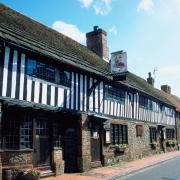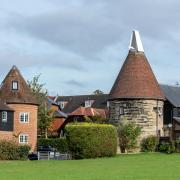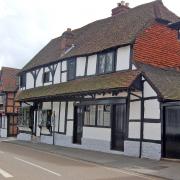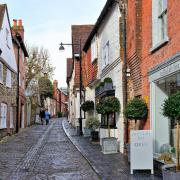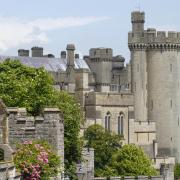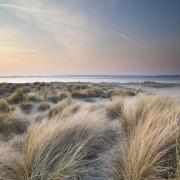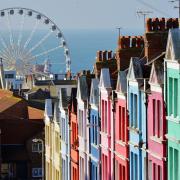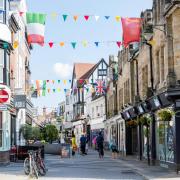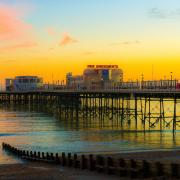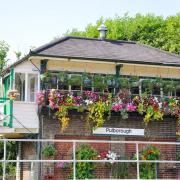Clustered around the village pond, the Saxon settlement of Rottingdean has become a bolthole for artists and writers, as well as a popular tourist spot
History
Rottingdean grew around the village pond during the Saxon period, before being taken over by William de Warrenne, the Lord of Lewes, as a reward for supporting William the Conqueror in the Battle of Hastings.
The village was subject to a raid by French pirates in 1377, who plundered and fired Rottingdean, including St Margaret’s Church where many were taking refuge.
Having begun life as a farming community it began to attract writers and artists in the late 19th century, including Sir Edward Burne-Jones and his nephew Rudyard Kipling, whose former garden is now a public space, and painter Sir William Nicholson who lived at The Grange from 1909 to 1914.
A pier at Rottingdean provided the eastern destination for Magnus Volk’s Daddy Long Legs seashore railway, which ran for three miles from Brighton’s Paston Place. Built on 24ft high stilts so up to 150 passengers could be carried above the high tide, the strange contraption ran from 1896 to 1901, but suffered many disasters along the way, including the track being washed away by a storm a week after opening.
Annual festival and events
Rottingdean Arts has organised an annual Spring Music Festival for the last seven years. The 2016 edition featured performances by the English Concert Singers and Orchestra, a workshop version of Handel’s Messiah and a jazz dinner at the Bistro Gourmand in Nevill Road.
This year saw the launch of a walking map of Kipling’s favourite haunts, following two festivals celebrating the great author’s links with the village. For more information about the festival visit www.kiplingfestivalrottingdean.co.uk.
There is a themed village fair in Kipling Gardens every summer.
Schools
• Primary: St Margaret’s Church of England Primary School, Whiteway Lane, Rottingdean, 01273 303109, Ofsted rating good; Our Lady of Lourdes Roman Catholic School, The Green, Rottingdean, 01273 306980, Ofsted rating good; Rudyard Kipling Primary School, Chalkland Rise, Woodingdean, 01273 303328, Ofsted rating good; Saltdean Primary School, Chiltington Way, Saltdean, 01273 303358, Ofsted rating good.
• Secondary: Longhill High School, Falmer Road, Rottingdean, 01273 304086, Ofsted rating requires improvement.
What to do
Sir William Nicholson’s former home The Grange is now a village museum and art gallery, with exhibitions about Rottingdean’s most famous residents, as well as showcases of current village talent. Just opened is the family-run JaxMar Gallery in High Street showcasing African art.
Saved from development by the Rottingdean Preservation Society, Kipling Gardens provides a beautiful oasis of calm away from what can be quite a busy road through the village. Among the attractions on the winding walks are the walled rose garden, a herb garden, and the village croquet club. The Preservation Society is also behind the restoration of the landmark windmill on Beacon Hill.
The 11th century Grade II listed St Margaret’s Church in the centre of the village boasts windows designed by Sir Edward Burne-Jones and made by the William Morris company.
And on a sunny day there is no better way to spend an afternoon than walking along the seafront cliff walk from Rottingdean to Brighton Marina.
Ameneties
Pubs include The Coach House, Queen Victoria and the 16th century Ye Olde Black Horse in High Street, The Plough in Vicarage Lane and the seafront landmark The White Horse Hotel. The High Street and around the beach offers a range of shops, including a Tesco Express and Co-op store, antique and charity shops, a bakery, butchers, post office, greengrocer, florist, jewellers and fashion retailers.
Restaurants and takeaways offer a range from traditional English tea room classics to Chinese, Thai and Indian cuisine.
The Whiteway Centre, in Whiteway Lane, hosts community events throughout the year as well as meetings by the village camera, wine, bridge, art, horticultural and flower clubs, as well as the Deans Orchestra.
The seafront terraces have been converted into an outdoor performance venue. It is programmed every summer by Rottingdean Arts who also put on shows in the village hall. For more information visit www.rottingdeanarts.org.uk.
Meet the neighbours
English folk legends The Copper Family have lived in and around Rottingdean for centuries. The songs sung by James “Brasser” Copper, who was born in the village in 1845, encouraged folklorist and musician Kate Lee to establish The Folk Song Society in 1899.
Writer Enid Bagnold, who wrote National Velvet, lived in the village for 60 years until her death in 1981 in Sir Edward Burne-Jones’s former home, North End House.
Council
Although the village comes under the Brighton and Hove unitary authority, Rottingdean is unique in that it has its own nine-member parish council too examining planning matters and monitoring any council proposals which could affect the village.
The estate agent’s view
“Rottingdean is a picturesque historic village,” says David Gregory of King and Chasemore, based in High Street, Rottingdean. “Originally a smugglers’ village, and then after the war mainly a retirement village, Rottingdean is now a mixture of old and young age groups and families, with two local primary schools in the area and Longhill secondary school close by. There is a selection of local village shops and tea rooms in the High Street, as well as five local pubs and inns, all leading down to the beachfront where there is a picturesque under-cliff walk along the coast. Brighton’s famous marina is also close by and offers a variety of shops, bars, restaurants, along with a casino, bowling alley, cinema, David Lloyd leisure complex, and a further pleasant under-cliff walk along the coast. The Sussex Downs walk and bridle path is on your doorstep and is an ideal tranquil location for dog walkers and families alike.”








